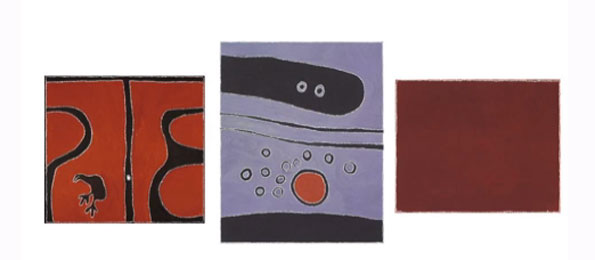As a conclusion of the series of events related to the exhibition Crossing Culture at the Toledo Museum of Art (US), IDAIA is sharing a relevant article written by Will Owen reporting his conversation with Henry Skerritt converation on “What Is It That Makes Australian Aboriginal Art So Appealing, So Contemporary?”. The two men interrogate Indigenous art in a broader sense, of world art – including the Western canon.

Paddy Bedford, l. to r., Emu Dreaming at Mt King; Two Women Looking at the Bedford Downs Massacre Burning Place; Bedford Downs Massacre
Photo © Will Owen
Make It New / Make It Now
By Will Owen, 4 August 2013
“On July 12, at the opening of the final weekend of the Crossing Cultures exhibition at the Toledo Museum of Art, Henry Skerritt came into town from Pittsburgh to join me in a conversation that Henry aptly titled (appropriating a line from the British artist Richard Hamilton), “Just What Is It That Makes Australian Aboriginal Art So Appealing, So Contemporary?”
It was a pleasure to finally share the stage with Henry. His knowledge not just of Aboriginal art, but of Indigenous art in a broader sense, of world art (including the Western canon), and the philosophical underpinnings of contemporary art history, theory, and criticism is fairly staggering. It’s been a long time since I was in graduate school reading Gadamer and Derrida and I turned away from my studies into librarianship before theory became core to humanistic studies. So sometimes I have a hard time keeping up with Henry, and if I misrepresent him here, I beg his forgiveness and his corrections.
The theme of Aboriginal art as contemporary art (and not just fine art) is one that has been bandied about over the course of the ten months that Crossing Cultures was on display at the Hood Museum and in Toledo. In order to discuss the concept, though, Henry backed up to talk first about modernisn. Showing photographs of work by the likes of Damien Hirst and Marina Abramovic, Henry argued that these works, although created quite recently, are actually engaged with modernity, a period he defined as beginning around the sixteenth century. It is characterized by “industrialization, nationalism, mass media—the invention of the printing press, [and] historical time.” Modernist artists, in one way or another, grapple with those themes in their work.
The contemporary period, in contrast, is characterized by globalization and the rise of Third World powers. The issues raised by the changing perspectives brought to bear by an increasingly interconnected world are the proper subject of what Henry would argue is truly contemporary art. I’ll put words in Henry’s mouth and say that I understood modernism to be a somewhat insular reaction to rapid cultural change in the Western world. Its products represent the artist’s attempt either to understand that change, or to fall back onto a psychological analysis of the inability to understand that change given conventional structures of thought. I can relate to this somewhat more easily in literature, my area of graduate study. There, the rise of the interior monologue and stream-of-consciousness narrative among the literary Moderns—Joyce, Woolf, Proust—mirrored the fracturing of the world afflicted by the trends that Henry identified: particularly the invention of historical time with its attendant demon of progress.
In contrast, contemporary artists are acutely aware of intercultural or even transcultural issues. The necessity to operate across conventional cultural bounds forces them to invest in the struggles of the moment. Quoting from Terry Smith, Henry asserted
Contemporary art is–perhaps for the first time in history–truly an art of the world. It comes from the whole world and frequently tries to imagine the world as a differentiated yet inevitably connected whole. (Terry Smith, Contemporary Art: World Currents, Laurence King Publishing, 2011).
For the inward-facing Moderns, painting became an end in itself: Monet’s inability to capture even the most fleeting impression of external reality led to the likes of Rothko, for whom the painting is a thing unto itself, without external referents at all. The contemporary artist, in contrast, is always reaching out beyond local convention and casting his work into the space where value systems confront one another.
The Modernist worldview, says Henry, was captured best by Ezra Pound–the Modernist sans égal–in his dictum “make it new.” The challenge for the contemporary artist is rather, “make it now.” Engage with the other. And this is precisely what Aboriginal artists have been doing since they made the first contemporary paintings in 1912. Yes, over one hundred years ago, when bark painters took up their brushes to reach across the chasm that separated them from that “other” we know as Baldwin Spencer.
This concept strikes at the heart of another theme that has resonated throughout all the discussions of Aboriginal art that took place over three months in Toledo. That is the precept that the art which hung on the gallery walls was created to instruct, and specifically to instruct “the other,” the whitefella, about the values and traditions of Aboriginal society”… [Read more]